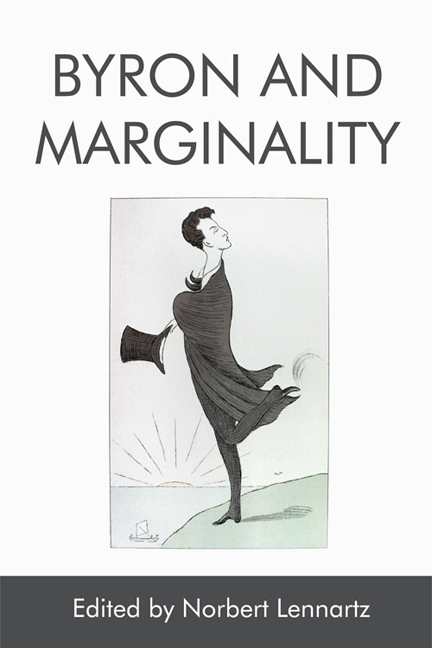Book contents
- Frontmatter
- Contents
- Foreword
- Acknowledgements
- Editions and Abbreviations
- 1 Lord Byron, Wandering and Wavering between the Centres and Margins of Romanticism: An Attempt at an Introduction
- I Byron’s Marginalisation in Romantic World Literature
- II Byron’s Marginal Identities and Places
- III Cherishing the Marginal – Marginal Genres in Byron
- IV On the Provocative Margins of Taste
- V Marginal Affairs – Visual and Paratextual Aspects in Byron
- List of Contributors
- Index
6 - At the Margins of Europe: Byron’s East Revisited and The Giaour
Published online by Cambridge University Press: 06 May 2021
- Frontmatter
- Contents
- Foreword
- Acknowledgements
- Editions and Abbreviations
- 1 Lord Byron, Wandering and Wavering between the Centres and Margins of Romanticism: An Attempt at an Introduction
- I Byron’s Marginalisation in Romantic World Literature
- II Byron’s Marginal Identities and Places
- III Cherishing the Marginal – Marginal Genres in Byron
- IV On the Provocative Margins of Taste
- V Marginal Affairs – Visual and Paratextual Aspects in Byron
- List of Contributors
- Index
Summary
Byron's East is an anomalous composite. It is framed by at least four elements. Firstly, it is framed by the power of the Ottoman Empire, which for Europeans had long been synonymous with the exotic, the unreadable and the systemically cruel. By Byron's time, the Empire had been in long decline, but it still retained a formidable residue of influence over a wide range of subject peoples. In the second place, there is the framing presence of a distant past, in the form of the complex associations attached to an ‘ancient Greece’, a Greece that was far more familiar to educated Europeans than any of the contemporary elements in the picture. Thirdly, there is a loosely defined Albanian dimension, formally part of the Ottoman Empire, though, with the rise to power of Ali Pasha from the 1780s, increasingly resistant to it. Fourthly, there is what might be described as ‘modern Greece’, though its identity and limits in the early nineteenth century are not always clearly definable. For many visitors, ‘modern Greece’ was, in any case, always a defused entity, sometimes completely overwhelmed by the knowledge of what Greece once had been.
Byron's youthful experience of this Eastern complex began in September 1809, when he and John Cam Hobhouse first arrived on Greek soil, and it ended in April 1811, when he left Greece to return to England. During this time away from home, Byron travelled to Tepelena in southern Albania, to meet with Ali Pasha (October 1809), settled in Athens (December 1809 to March 1810, July 1810 to April 1811) and visited Turkey, including Constantinople (March 1810 to July 1810). His immediate response to this early experience made him famous overnight, with the publication, in March 1812, of the first two Cantos of Childe Harold. Sometime after, probably in late 1812, he began the composition of The Giaour, which he subtitled ‘A Fragment of a Turkish Tale’; originally a poem of 344 lines, it progressively lengthened in subsequent versions, ending with the seventh edition of 1,334 lines in December 1813. Despite Byron's fears, the poem proved highly popular, with fourteen editions by 1815.
- Type
- Chapter
- Information
- Byron and Marginality , pp. 98 - 115Publisher: Edinburgh University PressPrint publication year: 2018



